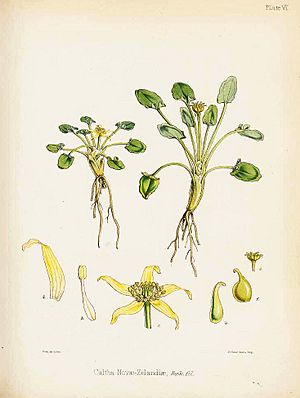New Zealand marsh marigold facts for kids
Quick facts for kids New Zealand marsh marigold |
|
|---|---|
 |
|
| plate VI, part 2, Flora Antarctica | |
| Scientific classification | |
| Genus: |
Caltha
|
| Species: |
novae-zelandiae
|
| Synonyms | |
|
|
The New Zealand marsh marigold (scientific name: Caltha novae-zelandiae) is a small, beautiful flowering plant. It's also called the yellow caltha. This plant is a perennial herb, meaning it lives for more than two years. It belongs to the Ranunculaceae family, which includes buttercups. You can only find this plant in New Zealand, making it endemic to that country. It usually grows in open, mountainous areas.
Contents
What's in a Name?
The name Caltha comes from an old Greek word, "kalathos." This word means 'goblet' or 'cup'. It describes the shape of the flower, which looks a bit like a small cup. The second part of its name, novae-zelandiae, simply means "from New Zealand." This tells us where the plant naturally grows.
Where Does It Grow?
The New Zealand marsh marigold lives in the mountains of New Zealand. You can find it on the North Island, South Island, and Stewart Island. It prefers cool, wet places.
Favorite Spots for This Plant
This plant loves to grow in damp areas. Look for it near mountain streams, around lakes, or in wet, grassy fields. It often grows among other small plants or even between gravel.
What Does It Look Like?
The Caltha novae-zelandiae is a small plant, usually about 3 to 5 centimeters (about 1 to 2 inches) tall. Sometimes, it can grow taller, up to 18 centimeters (about 7 inches). It's a smooth plant, meaning it doesn't have hairs.
Leaves and Stems
This plant grows in clumps of leaves called rosettes. It has thick, white underground stems called rhizomes. The leaves are shaped like spades. They have thin stems, called petioles, that can be up to 10 centimeters long. The leaf blades are dark green. Sometimes, they have a dark spot in the middle or bronze markings. Each leaf is about 8-25 mm long and 4-12 mm wide. They have two small lobes at their base and a slight dip at the tip. The edges of the leaves are smooth or slightly wavy.
Flowers and Seeds
The flower grows on a stem called a peduncle. This stem starts short but grows longer as the plant gets ready to make fruit. The flowers have five to seven pale yellow sepals. Sepals are like small leaves that protect the flower. These sepals are about 1-3 cm long. Inside the flower, there are 15 to 20 stamens (the parts that make pollen). There are also 6 to 12 carpels, which are the parts that will become seeds.
After flowering, the plant produces fruit heads that are about 12-18 mm wide. Each fruit is a follicle, and it usually holds two to five seeds. These seeds are small, about 1.2-2.0 mm long. They are shiny, reddish-brown to dark purple-brown.
When Does It Bloom?
The New Zealand marsh marigold flowers between September and December. You can find ripe fruits on the plant from December until March. This plant has 48 chromosomes.
How Is It Different from Similar Plants?
The Caltha novae-zelandiae is similar to another plant called Caltha obtusa. However, there are a few key differences. The New Zealand marsh marigold has yellow sepals that are long and narrow. In contrast, Caltha obtusa has white sepals that are wider and more oval-shaped. Also, the edges of the leaves on C. novae-zelandiae are mostly smooth or slightly wavy. The leaves of C. obtusa have more noticeable wavy edges and are almost lobed at the base.

